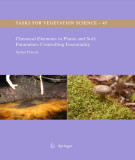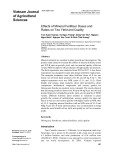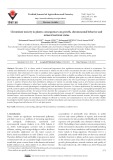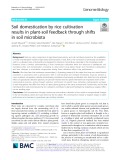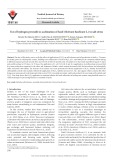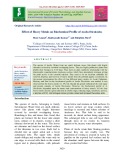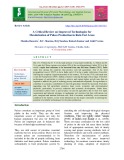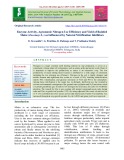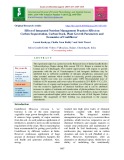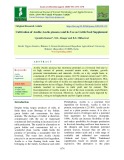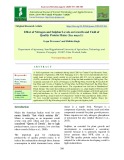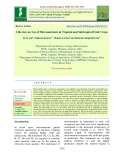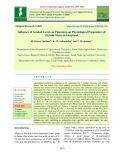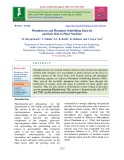
Essential plant nutrients
-
Ebook "Agronomic handbook: Management of crops, soils, and their fertility" covers both major agronomic fields. Containing essential data and information on the culture of the world's major agronomic grain, oil, fiber, and sugar crops grown on a wide range of soil types, Agronomic Handbook: Management of Crops, Soils, and Their Fertility serves as a practical reference on the management of crops and soils from planting to harvest.
 482p
482p  tracanhphuonghoa1007
tracanhphuonghoa1007
 22-04-2024
22-04-2024
 3
3
 2
2
 Download
Download
-
Ebook "Chemical elements in plants and soil: Parameters controlling essentiality (Tasks for vegetation science, Volume 45)" will have worldwide appeal for researchers interested in fields such as soil/plant interactions, bioinorganic chemistry, plant nutrition, phytomining, bioremediation, biogeochemistry, nutrient cycling, soil chemistry, and cellular physiology.
 200p
200p  manmanthanhla0201
manmanthanhla0201
 26-02-2024
26-02-2024
 3
3
 1
1
 Download
Download
-
Mineral nutrients are essential to plant growth and development. The present study aimed to evaluate the effects of mineral fertilizer doses and N:P:K ratio on growth, yield, and raw material quality of the tea variety PH10 to improve the production of high-quality tea products. The field experiment was conducted from 2015 to 2017.
 10p
10p  viengels
viengels
 25-08-2023
25-08-2023
 2
2
 2
2
 Download
Download
-
The present "Chromium toxicity in plants: consequences on growth, chromosomal behavior and mineral nutrient status" review describes the consequences of Cr toxicity on plants, including morphological, physiological and ultrastructural changes. This review also provides the basic concepts of Cr translocation and interaction with other essential macro- and microelements.
 19p
19p  lyhuyenthu
lyhuyenthu
 31-01-2023
31-01-2023
 9
9
 2
2
 Download
Download
-
Nitrogen (N) and phosphorus (P) are essential nutrients for plant growth and development. However, too much N and P can be toxic to plants and hurt crops and animals. Analysis and assessment of N and P content in soil and crops will help build a balanced and effective fertilizer plan for agricultural production. This study introduces a new method to determine both TP and TN in one process, reducing the analytical cost and time.
 7p
7p  visirius
visirius
 19-01-2023
19-01-2023
 6
6
 2
2
 Download
Download
-
Soils are a key component of agricultural productivity, and soil microbiota determine the availability of many essential plant nutrients. Agricultural domestication of soils, that is, the conversion of previously uncultivated soils to a cultivated state, is frequently accompanied by intensive monoculture, especially in the developing world.
 14p
14p  vielonmusk
vielonmusk
 30-01-2022
30-01-2022
 9
9
 0
0
 Download
Download
-
The aim of this study was to verify the effects of application of H2O2 on salt tolerance and oil production in basil cv. ‘Gennaro de Menta’ grown in a hydroponic system. Seedlings were subjected to 3 levels of H2O2 (0, 1, and 1000 μM) in a nutrient solution during 2 different exposure periods (24 and 48 h) and 2 levels of NaCl (0 and 80 mM). The plants were harvested at preflowering (at 15 days) and postflowering (at 25 days). At 25 days, the application of 1 μM H2O2 /48 h and its reapplication at preflowering increased leaf dry mass production compared to the other salt treatments.
 10p
10p  tudichquannguyet
tudichquannguyet
 29-11-2021
29-11-2021
 9
9
 1
1
 Download
Download
-
Phosphorus is an important macronutrient that is severely lacking in soils. In plants, specific microRNAs (miRNAs) essential for nutrient management and the regulation of stress responses are responsible for the control of many phosphate starvation responses. Further understanding of conserved and species-specific microRNA species has potential implications for the development of crops tolerant to soils with low phosphate.
 18p
18p  viseulgi2711
viseulgi2711
 31-08-2021
31-08-2021
 8
8
 1
1
 Download
Download
-
Durian (Durio zibethinus L.) is a highly popular fruit in Thailand and several other Southeast Asian countries. It is abundant in essential nutrients and sulphur-containing compounds such as glutathione (GSH) and γ-glutamylcysteine (γ-EC).
 14p
14p  vijichea2711
vijichea2711
 28-05-2021
28-05-2021
 8
8
 1
1
 Download
Download
-
The species of Azolla (Water fern) are small, delicate, moss- like plants with fragile rhizomes covered by crowded overlapping leaves. They are highly productive plants that double their biomass in 3–10 days. They form an endo symbiotic relationship with the diazotrophic cyanobacterium Anabaena azollae, which fixes atmospheric nitrogen, giving the plant access to the essential nutrient.
 25p
25p  cothumenhmong9
cothumenhmong9
 04-01-2021
04-01-2021
 5
5
 1
1
 Download
Download
-
These growth factors in combination with the better nutritional condition due to increased availability of Phosphours might in soil have played a role in increasing the grain yield. VAM not only supplies essential nutrients but also water to plants resulting in better growth that led to increasing grain yield. Yadav and Shrivastava (1997) recorded similar findings.
 11p
11p  gaocaolon9
gaocaolon9
 22-12-2020
22-12-2020
 9
9
 1
1
 Download
Download
-
Nitrogen is a major essential yield limiting nutrient in crop production, it serves as a constituent of many plant cell components, such as amino acids and nucleic acids. Hence it is important to improve the productivity as maize is an exhaustive crop. The low productivity of maize during kharif season is attributed to a wide range of constraints including the low nitrogen use efficiency.
 6p
6p  gaocaolon9
gaocaolon9
 22-12-2020
22-12-2020
 14
14
 2
2
 Download
Download
-
Greens are among the most productive plants in terms of nutritional value per unit area, because they grow rapidly and can have several crops in a season. They contribute sufficient amounts of vitamin A and C and several minerals even after losing some of the constituents while cooking. The need for green food is being greatly emphasized owing to the increase in knowledge of value of essential minerals and vitamins. They could be used as an important source of nutrients during the pre-cropping season, before traditional crops are available for human consumption.
 14p
14p  trinhthamhodang1216
trinhthamhodang1216
 19-11-2020
19-11-2020
 13
13
 2
2
 Download
Download
-
The experiment sight was carried out in the Research farm of Indira Gandhi Krishi Vishwavidyalaya, Raipur during Rabi season 2013-14. Raipur is situated in the Central part of Chhattisgarh. The notable improvement with respect to growth parameters with the use of Vermicompost-A and inorganic fertilizers may be attributed due to sufficient availability of nitrogen, phosphorus, potassium and other essential nutrients which resulted in increasing growth parameters.
 9p
9p  chauchaungayxua8
chauchaungayxua8
 03-10-2020
03-10-2020
 22
22
 2
2
 Download
Download
-
The continuous use or excess supply of inorganic fertilizers as source of nutrient in imbalanced proportion is also a problem, causing economic inefficiency, damage to the environment and in certain situations, harm the plants themselves and also to human being who consume them. On the other hand, increase in productivity of horticultural produce removes large amounts of essential nutrients from the soil. Without proper management, continuous production of crops reduces nutrient reserves in the soil.
 9p
9p  quenchua8
quenchua8
 29-09-2020
29-09-2020
 13
13
 1
1
 Download
Download
-
They form a symbiotic relationship with the cyanobacterium Anabaena azollae, which fixes atmospheric nitrogen, giving the plant access to this essential nutrient. Azolla has been used successfully as a protein supplement to replace meal in diets for livestock. According to Ambade et al., (2010), milk yield was increased by 15 to 20% after feeding azolla in the diet of dairy cows.
 5p
5p  kethamoi7
kethamoi7
 26-08-2020
26-08-2020
 12
12
 1
1
 Download
Download
-
Sulphur, an essential for plant growth and development is considered a secondary nutrient because it is generally required in lower amounts than NPK (Jeet et al., 2014).The quality protein maize has widely adopted for cultivation in developing world to fight malnutrition.
 4p
4p  nguaconbaynhay7
nguaconbaynhay7
 15-08-2020
15-08-2020
 15
15
 0
0
 Download
Download
-
Plant nutrition plays a major role in quantitative and qualitative crop production in bringing sustainability and plants require seventeen essential elements for their normal growth and development. Among these, those elements required smaller in quantity is called micronutrients (Fe, Cu, Zn, Mn, B, Cl, Mo and Ni). Micronutrients are essentially as important as macronutrients to have better growth, yield and quality in plants.
 10p
10p  caygaocaolon6
caygaocaolon6
 30-07-2020
30-07-2020
 27
27
 3
3
 Download
Download
-
Agricultural production continues to be constrained by a number of biotic and abiotic factors that can reduce crop yield quantity and quality. Potassium (K) is an essential nutrient that affects most of the physiological processes that influence plant growth. To understand the effect of potassium, a pot culture experiment was carried out with graded levels of potassium to study the influence of potassium on physiological parameters of maize in black calcareous and non-calcareous soils.
 7p
7p  angicungduoc6
angicungduoc6
 22-07-2020
22-07-2020
 13
13
 2
2
 Download
Download
-
Phosphorous (P), an essential nutrient element is the second most important element after nitrogen. It is unavailable to plants because in the soil it is mostly present in the fixed form. Soil bacteria having the phosphate solubilizing capacity are called as Phosphate Solubilising Bacteria (PSB). They convert the insoluble phosphate into soluble form through the production of organic acids and make it available for plant uptake and nutrition. They are also useful as biofertilizers as they belong to the plant growth promoting Rhizobacteria.
 12p
12p  angicungduoc6
angicungduoc6
 20-07-2020
20-07-2020
 17
17
 1
1
 Download
Download
CHỦ ĐỀ BẠN MUỐN TÌM









